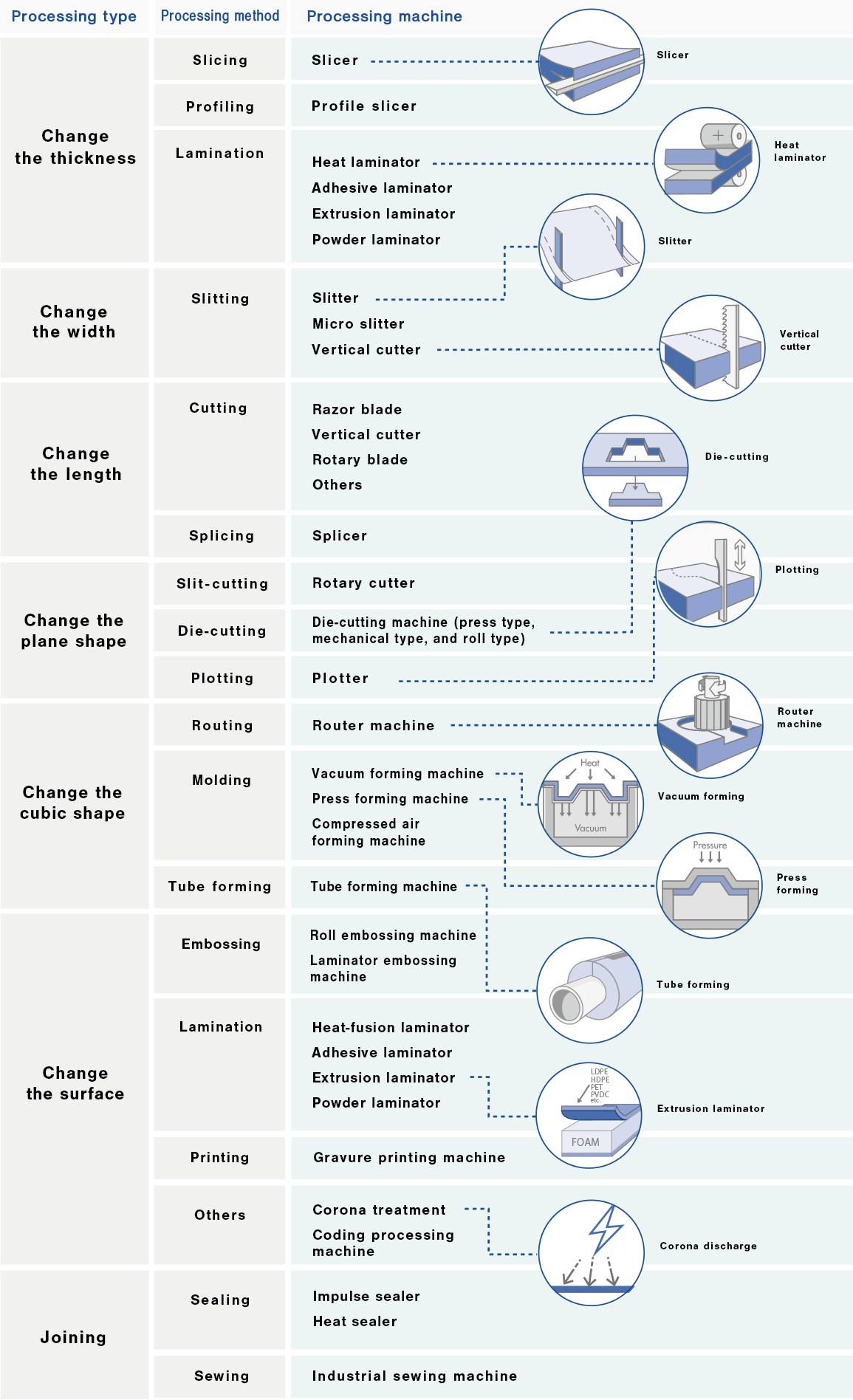SOFTLON What is Softlon?
Softlon solutions
Foam types
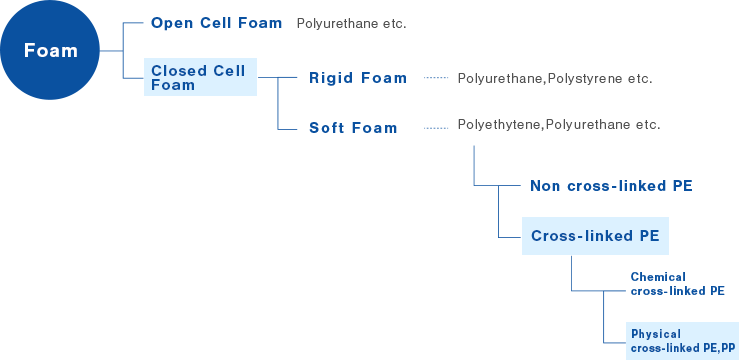
Foam
It is a type of plastic product in which air bubbles are dispersed to make it porous. It is also called “foam,” a collection of small “bubbles.” A foam contains a lot of air in it and thus is light weight and has excellent property for cushioning and thermal insulation. We can see products made of foam at home, such as a washing sponge in the kitchen and a cushioning material for chairs and pillows.
Closed Cell Foam
It is a structure of foam where the inner bubbles are independent, not connected to each other. When the inner bubbles are connected to each other, it is a structure called “open cell.” Closed cells do not easily release the inner air. So, they moderately bounce, quickly recover their original shape, absorb no water, and resist water.
Cross-linked PE
It is a reaction to combine polyethylene molecular chains. By crosslinking the molecular structure, strength, heat resistance, chemical resistance, etc. can be improved. This is called crosslinking because the reaction combines each long molecular chain like a bridge.
Physical cross-linked PE,PP
Emitting an electron beam on a polymer material can break some molecular bonds and generate active spots (radicals). irradiation crosslinking is a technique to bond these active spots to each other. Compared to chemically cross-linked products, irradiation cross-linked products are more uniform and stable. The advantages include a soft and smooth surface, and good color development without using a crosslinking agent.
Manufacturing process
Extrusion process
Main raw materials (PE/PP) are mixed with a blowing agent and other materials and extruded into sheets.
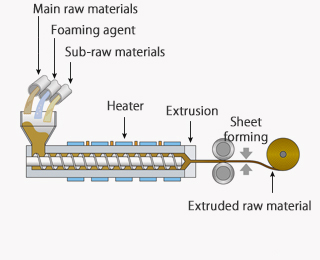
Irradiation process
We strengthen bonds at the molecular level by exploiting our proprietary irradiation crosslinking technology.
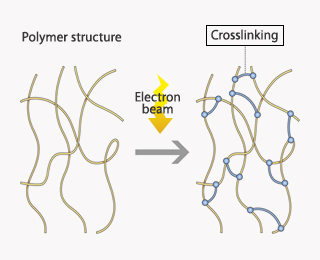
Foaming process
Sheets are foamed by heating, creating a foam with a volume of up to 40 times.
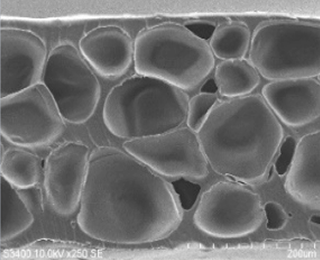
Core technology
- 1
Polyolefin-based
Processing polyolefin resin into sheets
Mixing polyolefin resin with a blowing agent and sub-raw materials, and extruding the mixture into sheets. The sheet thickness can be precisely controlled with proprietary forming technology.
Features・Heat resistance・Sealing of uneven surfaces・Flexibility・Electrical characteristics・Chemical resistance/Oil resistance・Low environmental load - 2
Electron beam crosslinking-based
Molecule structure further strengthened with electron beam application
Formed sheets are crosslinked with proprietary electron beam application technology, bringing excellent mechanical strength and smoothness, which cannot be obtained with chemical crosslinking.
Features・Strength/Toughness・Thermoformability・Heat resistance・Thinness・Smoothness・Workability - 3
Closed cell foam
Foam foaming by heating
Sheets are foamed by heating, which creates closed cell foam that are superior in thermal insulation and shock absorption compared to Open cell foam.
Features・Water resistance/Water absorption・Thermal insulation・Shock absorption・Electrical characteristics・Smoothness・Workability
Positioning of main products
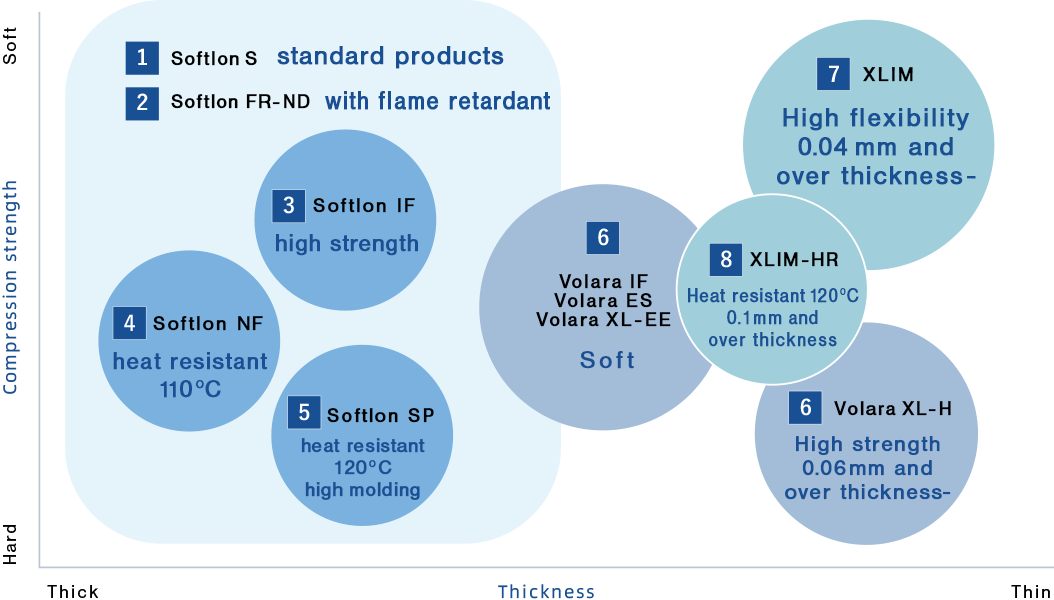
- 1 Softlon S
- 2 Softlon FR-ND
- 3 Softlon IF
- 4 Softlon NF
- 5 Softlon SP
- 6 Volara IF,ES,XL-EE,XL-H
- 7 XLIM
- 8 XLIM-HR
Product information
ProductsDevelopment information
New TechnologyDownload product documents
DownloadInquiries about products
Contact
Features and functions
- Water resistance/Water absorption
- Strength/Toughness
- Flexibility
- Heat resistance
- Thermal insulation
- Thinness
- Shock absorption
- Sealing of uneven surfaces
- Thermoformability
- Smoothness
- Electrical characteristics
- Chemical resistance/Oil resistance
- Low environmental load
- Workability
Download product documents
DownloadWater resistance
Water absorption
Closed cell foam made of polyolefin resin having low water absorption impregnable to water
Since polyolefin is lipophilic resin, it is a low-hygroscopicity material. The cells in Softlon are not connected, which does not allow entry of water, exhibiting excellent water resistance. In the long history of Softlon, this feature has extended its applications from bathroom mats to packing materials.
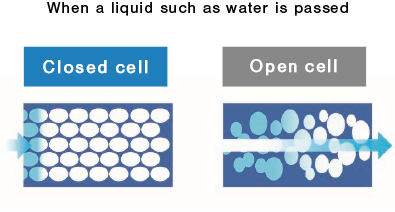
Strength
Toughness
Widely used as a sturdy yet flexible material with superior heat resistance over non-crosslinked foam
Crosslinking the molecular structure with entangled string-like polymers further tightens the molecular bonds, which results in a molecular lattice mesh structure, improving heat resistance and strength. With these structural features, Softlon is highly regarded for its sturdiness and flexibility compared to non-crosslinked polyolefin foam.
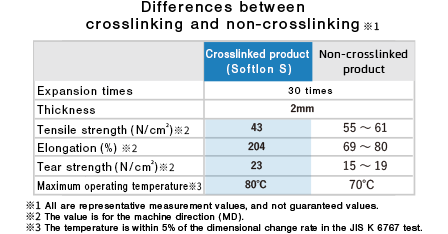
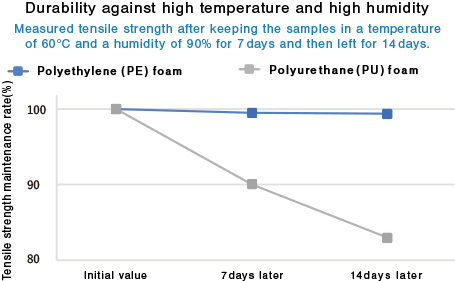
Flexibility
Resin’s intrinsic softness and closed cell structure providing reasonable bouncing and cushioning
The cell of electron-crosslinked sheets will contain more air in the later foaming process. Cells with various expansion times create a closed cell structure in which all cell are separated with walls.
Different with a open cell structure, a closed cell structure has unique cushioning and shock absorption characterized with reasonable bouncing with no bottoming out (touching the base when pressed down).
Having excellent shock absorption even with small thickness, Softlon sheets are used package cushioning for precision instruments.
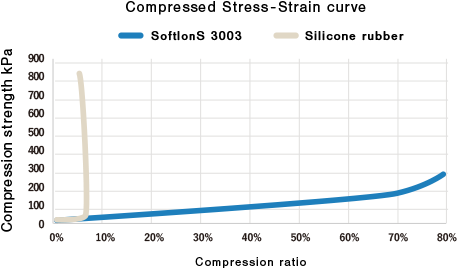
Heat resistance
With excellent heat-resistance, polypropylene (PP) resin has minimal thermal shrinkage even in the high temperature range.
The rate represents how much the foam changes in size at each temperature when heated without an external force applied. While polyethylene foam deforms as shown in the figure on the right when heated to 80°C or higher, polypropylene foam has excellent heat resistance with a shrinkage rate of 3% or less even at 140°C.
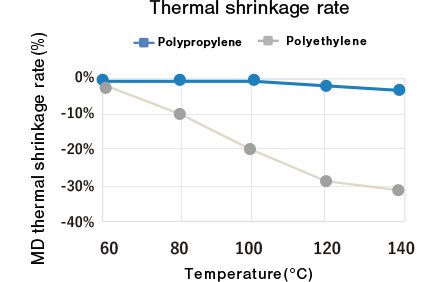
Thermal insulation
Foam containing a large amount of air with minimized convection resulting in low thermal conductivity and superior thermal insulation performance
Containing a large amount of air with high expansion times, Softlon has superior thermal insulation (= lower thermal conductivity) compared to general insulations. Each small cells in foam is closed so that the amount of convection is limited, conducting little heat, which is thought be the reason for excellent thermal insulation. Different from glass wool and rigid foam, Softlon is easy to forming and good installation. Therefore, it is suitable for insulators for filling very small spaces in houses and various machinery.
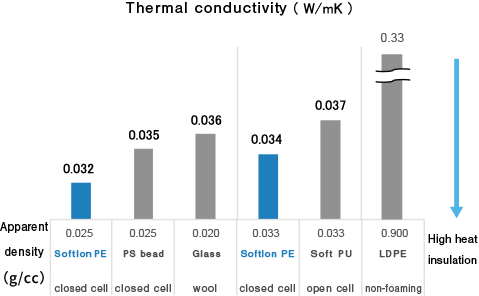
Thinness
Sekisui’s proprietary thinning technology realizes thin foam of 1 mm or less.
An ordinary foam increases its volume by foaming. However, the thin foam proposed by Sekisui minimizes the cell size of the bubbles during foaming to reduce the thickness of the products to the utmost limit, thus contributing to the downsizing of electronic devices.
Shock absorption
With the inherent flexibility of the resin and the bubble cell structure of the foam, the physical high-speed pressure (shock energy) is evenly dispersed.
Shock energy is generated when an object moves and physically contact with another object. The shock can be absorbed by converting it into heat energy.
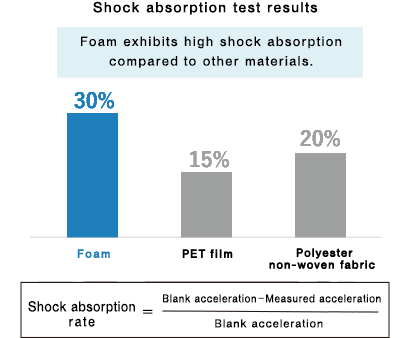
Sealing of uneven surfaces
With its flexibility, the foam seals uneven or sharp surfaces to achieve high sealing property.
The sealing property of a sealer such as tape is greatly affected, not only by the properties of the material substance, but also by its close physical contact with the uneven surface of the adherend. A material with high flexibility eliminates gaps with the adherend and realizes high sealing performance.
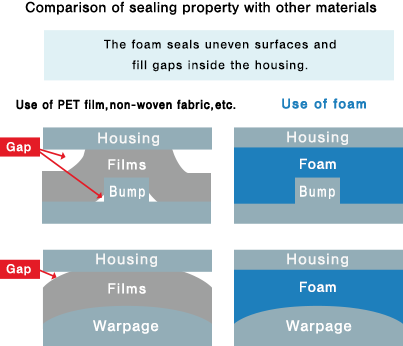
Thermoformability
Polypropylene (PP) resin has excellent heat-stability, Softlon SP can withstand high temperatures during molding, enabling highly deep drawability.
Polypropylene (PP) has a higher melting point than polyethylene (PE).
Therefore, with its excellent heat resistance even at high temperatures during molding, PP can achieve both excellent thermoformability and cushioning. Specifically, PP is widely used for automotive interior trim materials and fruit protection trays.
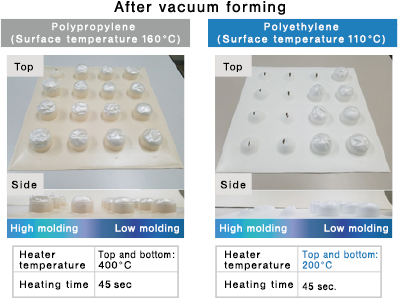
Smoothness
An even and clean surface with finer cells compared to chemical crosslinked foam, suitable for adhesion and coating
Electron beam crosslinking is a crosslinking process that accelerates electrons with a high voltage and emits them onto sheets. Since the beam electrons evenly and stably penetrates through each sheet, the resulted crosslinking is more uniform compared to other methods including that using a crosslinking agent such as peroxide (chemical crosslinking). Uniform crosslinking enables even foaming, which creates a smooth surface layer suitable for adhesion and coating.
Electrical characteristics
Closed cell foam containing a large amount of air providing excellent dielectric strength and low permittivity.
Closed cell structure, in which air with low dielectric strength is enclosed in separated small spaces, exhibits superior dielectric strength. In addition, polyolefin, which has a relatively low permittivity compared to other general-purpose plastics, formed in a structure containing air provides even lower permittivity.
With attention focused on these features, Softlon has been used to pack precision instruments and fragile modules such as RFID tags.
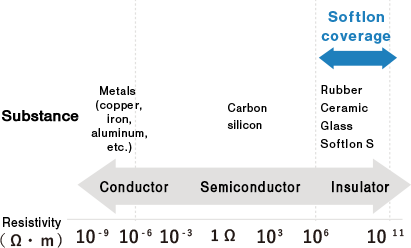
Chemical resistance
Oil resistance
With superior resistance against acids, alkalines, organic solvents, and other chemicals, used in many industries
Softlon, mainly composed of polyethylene, inherits the high chemical resistance of the main component. With superior resistance against acids, alkalines, and organic solvents, which have adverse effects on other foaming materials including swelling, shrinking, and to dissolving, Softlon is serving various industries from the background.
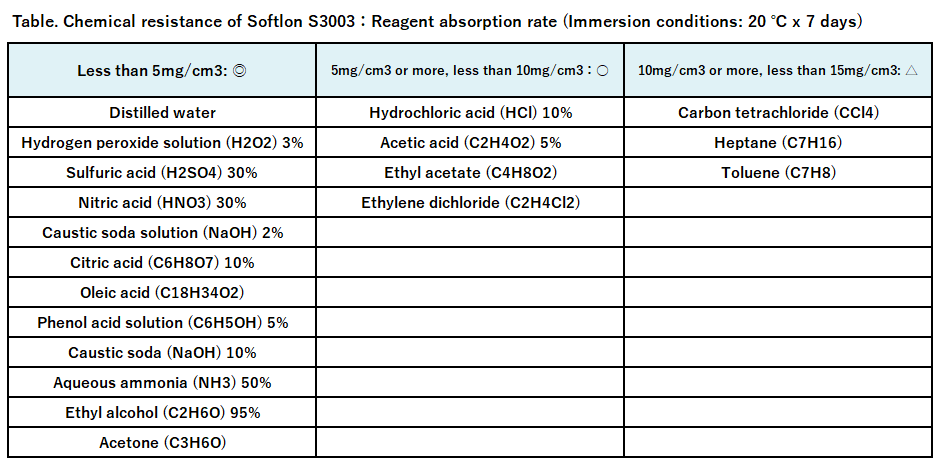
Low environmental load
Being halogen-free, generating no toxic gases when burnt
Polyolefin is a type of plastic. It is the generic name of a polymer (resin) obtained by synthesizing monomers (i.e. unit molecule) with a carbon-carbon double bond.
Softlon is foam mainly composed of polyolefin (principally polyethylene). Since it does not contain halogens such as fluorine and chlorine, it does not generate highly toxic gases when burnt.
Workability
Excellent shape stability realizes various processing.
Using thermoplastic polyolefin resin, Softlon can change the fluidity of the polymer by changing the temperature. By heating and melting, it can attach other materials or deform the foam. By taking advantage of the shape stability at room temperature, it can also be cut into complicated shapes.
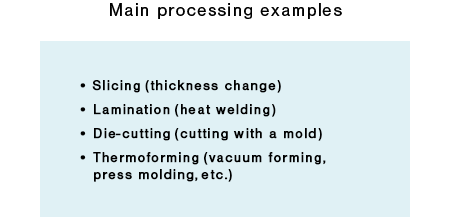
Workability
